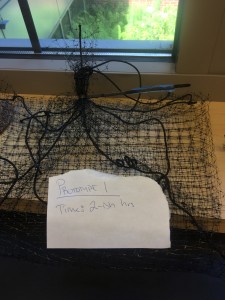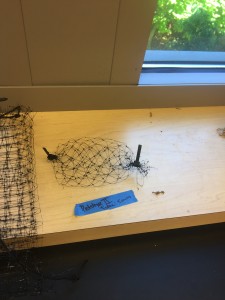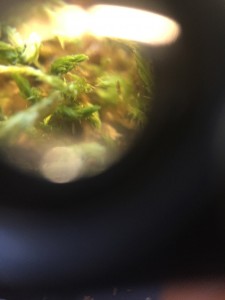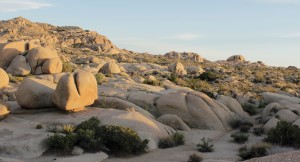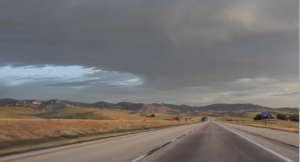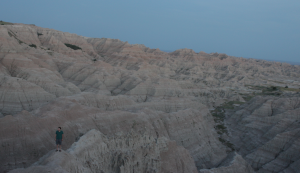
A clump of healthy Pisaster ochraceous on San Juan island
Sitting here in the sun with my feet pressed familiarly against Harned’s red brick patio, I can’t help but be overtaken by a strange feeling. It seems as if the summer is flying by ever so slowly. The past two months spent conducting summer research here at Puget Sound have been a kind of exhilarating whirlwind that I could never have anticipated during the frantic weeks I spent writing my proposal in the winter. On one long drive between study sites, I was shocked to realize that in the past two months I have seen about 2,000 different sea stars. This sheer number has trained my eyes to instantly identify the species of a sea star and evaluate its health with a sensitivity that only repetition can offer.
But perhaps I should retrace my steps and introduce my research. My name is Haila, and I am a rising Junior majoring in Biology with a minor in English. I’m currently working with Dr. Joel Elliott and fellow student Katie Pyne to evaluate the effects of sea star wasting disease. This aptly-named marine epidemic has traveled up and down the western coast of the United States, brutally dissolving our beloved celestial echinoderms. The cause of wasting disease and the way in which it is transmitted is still very mysterious, although researchers get closer to finding an answer each day. Fortunately, Dr. Elliott and his students have been closely monitoring local sea star populations for years, providing us with solid baseline data to which we can compare the condition of present populations.
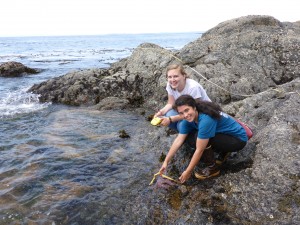 On the days of the month with the lowest tides, Katie and I venture out to the rocky intertidal, GPS and measuring tape in hand, and collect data on every sea star we can find along a previously established transect. We try to collect as much data as we can so that we can be prepared to answer as many questions about the disease as we can. For each of the 2,000 sea stars mentioned above, we have data on species, arm length, color, GPS coordinates, tidal height, arm loss, and sickness level. We then randomly sample the area of the beach in which we expect the sea stars would be feeding, usually in the mussel zone or the barnacle zone. Since sea stars are keystone predators (they are integral to the diversity of their communities because they prey on and suppress hearty organisms like mussels and barnacles that might otherwise dominate the inter-tidal), we would expect a change in sea star populations to set off a change in the populations of their prey items. However, this change will likely occur more gradually than can be observed in the length of a summer, so we hope to provide a baseline for comparison in the future. When the tides are less than ideal, we return to the lab to study the behavior and physiology of baby sea stars, but we’ll save that project for another blog post.
On the days of the month with the lowest tides, Katie and I venture out to the rocky intertidal, GPS and measuring tape in hand, and collect data on every sea star we can find along a previously established transect. We try to collect as much data as we can so that we can be prepared to answer as many questions about the disease as we can. For each of the 2,000 sea stars mentioned above, we have data on species, arm length, color, GPS coordinates, tidal height, arm loss, and sickness level. We then randomly sample the area of the beach in which we expect the sea stars would be feeding, usually in the mussel zone or the barnacle zone. Since sea stars are keystone predators (they are integral to the diversity of their communities because they prey on and suppress hearty organisms like mussels and barnacles that might otherwise dominate the inter-tidal), we would expect a change in sea star populations to set off a change in the populations of their prey items. However, this change will likely occur more gradually than can be observed in the length of a summer, so we hope to provide a baseline for comparison in the future. When the tides are less than ideal, we return to the lab to study the behavior and physiology of baby sea stars, but we’ll save that project for another blog post.
So far, Katie and I have had the privilege to explore some of the most rich and beautiful intertidal zones that Western Washington has to offer, from the locals sites in the Tacoma area to the beautiful shores of San Juan Island to the rugged points of the Olympic Peninsula that house the largest organisms we’ve seen. Personally, I am infatuated with the intertidal zone and the organisms that inhabit it, and this research seems so suited to my love of the outdoors. I spend my time sitting in tide pools, climbing slimy boulders, and crouching down to peer under rocks. In a way, it has given a focused direction to my time spent surrounding myself in wild environments and examining, with wonder, nature.
I have always seen science as a place for mystery-solving, elucidation, and exploration. In the past few months, sea star wasting disease has wriggled itself into the public eye with the flashy appeal of its mysterious cause and its gruesome, zombie-like effects. While to the general public sea star wasting disease is a devastating condition destroying a highly recognizable and culturally significant organism, I feel fortunate that I have been given the opportunity to spend time examining the disease from a scientific, ecological perspective. To me, this epidemic is incredibly complex in its effects and implications.
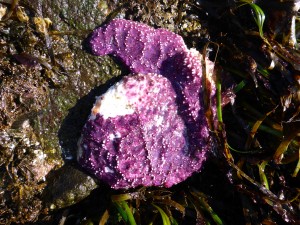
A wasting Pisaster ochraceous on the Olympic Peninsula
Although community interactions are so elegantly intricate and important, they have long been the ecologist’s foil. An animal living in the intertidal is affected by a myriad of different factors: abiotic influences like temperature, wave action, and substrate type can vary immensely among sites, within a habitat, and even from one rock to the next. And, to add to this, all of the organisms that share an environment are connected in dizzying webs that are undoubtedly even more complicated than we understand. And this is what has made our research simultaneously frustrating and interesting, providing us with an abundance of questions and few answers. I’ll try to provide you with a snapshot of where we are at right now. Sea stars are wasting, and the culprit is likely a virus. It seems simple enough, right? But once we ask one question, it only sprouts more and more opportunities for inquiry. We might ask, how do sea stars contract the virus? Can it be transmitted through water? Through contact? Through the shellfish that the sea stars eat? We are seeing huge variation among different habitats, and different types of sea stars seem to be differentially affected. So, is the disease aggravated by temperature? Wave action? Prey source? Are certain types of sea stars affected more than others (are small ones more resistant)? Are the sea stars that we see without lesions completely healthy, or does the virus have a substantial incubation time? We see a high recruitment of baby sea stars. Will they be healthy, or will they become infected when they grow up? If the disease results in a large loss of sea stars, which are keystone predators, what will happen to the communities they left behind? Will the mussels and barnacles dominate?
Perhaps most frustratingly, it is likely that each location will respond differently. Differences in mussel population in different habitats could be the result of differences in settlement, differences in food levels, and differences in the availability of good places to live. All of these factors are likely to effect the response of a mussel community to the absence of sea stars due to sea star wasting disease. However, even with the seemingly daunting lack of control that ecologists face in the field, we are not discouraged. These questions remind me of how much we still have to discover, and this opportunity for contribution (combined with pure curiosity) acts as the fuel for a researcher’s motivation. This summer has been a lesson in flexibility, careful planning, and persistence. I can already tell that the skills I am gaining now will be valuable in the remainder of my education and beyond. Thanks for reading!
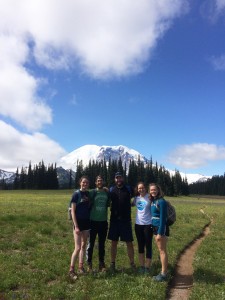 Weeks before the summer even began, Dr. Bryan Thines, PhD, my research advisor and a professor of biology and genetics at Puget Sound, challenged me to a beard-growing competition. “I like to have friendly games within our labs,” he told me after I received my research grant. “It encourages both competition and camaraderie.” I had already been pranked once by my lab after I misspelled the word “assess” on a poster for a presentation, so I should have assumed that our summer work would be just as mischievous as the previous semester.
Weeks before the summer even began, Dr. Bryan Thines, PhD, my research advisor and a professor of biology and genetics at Puget Sound, challenged me to a beard-growing competition. “I like to have friendly games within our labs,” he told me after I received my research grant. “It encourages both competition and camaraderie.” I had already been pranked once by my lab after I misspelled the word “assess” on a poster for a presentation, so I should have assumed that our summer work would be just as mischievous as the previous semester.
